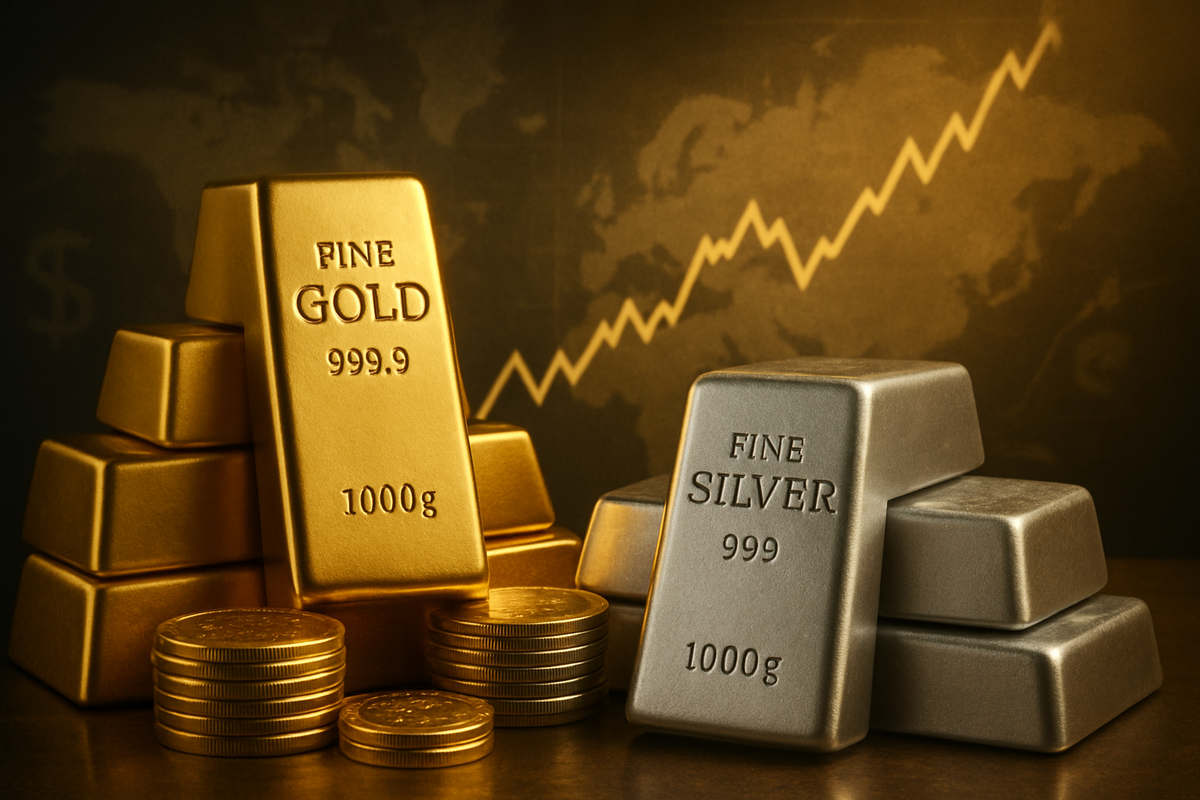
2025 has witnessed an extraordinary ascent in the prices of gold and silver, with both precious metals achieving unprecedented nominal highs. This dramatic surge has ignited fervent discussions among investors and analysts alike, raising critical questions about the sustainability of these gains and whether the current market presents an opportune moment for profit-taking. While the initial rally saw gold breach an astonishing $4,398 per ounce and silver reach a new all-time high of $55.51 per ounce in October, subsequent sharp corrections have introduced a layer of volatility, urging a careful re-evaluation of investment strategies.
The remarkable performance of gold and silver, with year-to-date gains of 58% and 69% respectively, underscores a fundamental shift in investor sentiment driven by a confluence of monetary policy changes, escalating geopolitical tensions, and persistent inflation concerns. This rally reflects a renewed flight to safety and a growing apprehension regarding the stability of traditional fiat currencies. However, the recent price corrections serve as a potent reminder of the inherent volatility in the precious metals market, compelling investors to meticulously weigh the long-term bullish outlook against the immediate risks of a potential downturn.
Unpacking the 2025 Precious Metals Phenomenon
The dramatic surge in gold and silver prices throughout 2025 is a story woven from several threads, culminating in a period of intense market activity. The initial catalyst for this upward trajectory can be traced back to the US Federal Reserve's decision to commence interest rate cuts in September 2025, with further reductions anticipated by mid-2026. Lower interest rates diminish the opportunity cost of holding non-yielding assets like precious metals, making them increasingly attractive compared to bonds or cash. This monetary policy pivot, coupled with ongoing concerns over currency debasement and a weakening U.S. dollar, laid a fertile ground for the metals' rally.
Further fueling the fire were escalating geopolitical tensions and economic uncertainties that permeated the global landscape. New tariffs announced by US President Donald Trump, notably the "Liberation Day" tariffs, triggered a sharp selloff in equity markets, pushing investors en masse towards safe-haven assets. This flight to safety was compounded by persistent global fiscal policy concerns and inflationary pressures, which eroded confidence in traditional financial instruments. Central banks, particularly in emerging markets, emerged as significant players, continuing their trend of increasing gold purchases to diversify reserves away from the U.S. dollar and mitigate perceived confiscation risks. This institutional demand was mirrored by a surge in private investor appetite, evidenced by substantial inflows into gold and silver exchange-traded funds (ETFs) throughout 2025, indicating robust retail and institutional conviction.
The silver market, in particular, benefited from its dual role as both a precious and an industrial metal. Resilient industrial demand, driven by its critical use in green technologies such as solar panels, electric vehicles, and electronics, provided an additional boost. The silver market has faced structural supply challenges, with demand consistently outstripping supply since 2020, leading to persistent deficits. A decade of underinvestment in new silver mines, coupled with the fact that most silver is a byproduct of other mining operations, has made supply less responsive to demand spikes. This physical shortage, including tight inventories in London and Shanghai vaults, contributed significantly to the price surges. Initial market reactions were characterized by euphoria, with analysts and investors celebrating the return of precious metals as a dominant force. However, the euphoria was tempered by sharp corrections in late October, with gold falling over 6% and silver nearly 10% in a single day, signaling increased volatility and prompting a reassessment of market momentum.
Companies Navigating the Precious Metals Boom
The unprecedented surge in gold and silver prices in 2025 has created a clear divide between potential winners and losers across various industries, profoundly impacting public companies.
On the winning side, gold and silver mining companies are experiencing a significant boon. Companies like Barrick Gold Corp. (NYSE: GOLD) and Newmont Corporation (NYSE: NEM) are seeing their revenues and profit margins expand substantially as the value of their primary products skyrockets. Higher metal prices directly translate to increased profitability, allowing these companies to boost exploration budgets, reduce debt, and return capital to shareholders through dividends or buybacks. Similarly, silver miners such as Pan American Silver Corp. (NASDAQ: PAAS) and Hecla Mining Company (NYSE: HL) are enjoying enhanced financial performance, benefiting not only from higher silver prices but also from robust industrial demand for the metal. Companies involved in precious metals streaming and royalties, like Franco-Nevada Corporation (NYSE: FNV), also stand to gain significantly, as their income streams are directly tied to the production and price of these metals.
Conversely, industries heavily reliant on silver as an input material face considerable challenges. Electronics manufacturers, solar panel producers, and electric vehicle companies are grappling with significantly increased raw material costs. For instance, companies like First Solar, Inc. (NASDAQ: FSLR) and other solar energy firms, which use silver in photovoltaic cells, will see their production expenses rise, potentially squeezing profit margins or necessitating price increases for their end products. This could lead to a focus on supply chain efficiency, exploring alternative materials, or absorbing higher costs, which might affect their competitiveness. Jewelers and luxury goods manufacturers, while potentially benefiting from the perceived value of gold and silver, might also face higher procurement costs, which they may or may not be able to fully pass on to consumers, depending on market elasticity. Furthermore, companies that had hedged their precious metal exposure at lower prices might miss out on the full extent of the rally, while those with significant short positions could face substantial losses.
Broader Implications and Historical Context
The 2025 surge in gold and silver prices is not an isolated event but rather a significant development within broader industry trends, reflecting a complex interplay of macroeconomic forces and geopolitical shifts. This rally underscores a global trend towards de-dollarization and diversification among central banks, particularly those in emerging economies. The sustained increase in gold purchases by these institutions since 2022 highlights a strategic move to reduce reliance on the U.S. dollar as a primary reserve asset, driven by concerns over geopolitical weaponization of finance and the desire for greater monetary sovereignty. This trend aligns with historical precedents where geopolitical instability and economic uncertainty have consistently driven demand for tangible assets.
The event also has potential ripple effects on competitors and partners across the financial landscape. For instance, the increased attractiveness of precious metals could draw investment away from other asset classes, such as certain equities or government bonds, particularly if real interest rates remain low or turn negative. This could put pressure on fund managers whose portfolios are heavily weighted towards these alternative assets. Furthermore, the volatility observed in the precious metals market could spill over into broader commodity markets, influencing investor sentiment and risk appetite across the board. Regulatory bodies might also begin to scrutinize the precious metals market more closely, especially concerning trading practices and market manipulation, given the rapid price movements and increased speculative interest.
Historically, periods of high inflation, geopolitical conflict, and monetary easing have almost invariably led to strong performance in precious metals. The current environment, characterized by persistent inflation concerns, ongoing trade disputes, and interest rate cuts by the Federal Reserve, echoes conditions seen in the 1970s and early 2000s, both periods of significant precious metals rallies. The current gold-silver ratio, despite silver's impressive gains, suggests that silver may still be undervalued relative to gold, reminiscent of periods preceding major silver price explosions. This historical context provides a strong foundation for the current rally, suggesting that the underlying drivers are not merely speculative but rooted in fundamental economic and political realities. The ongoing supply deficits in the silver market, coupled with its critical role in the burgeoning green economy, further solidify its long-term structural demand, differentiating this rally from purely speculative bubbles of the past.
What Lies Ahead for Precious Metals
Looking ahead, the trajectory of gold and silver prices will be shaped by a delicate balance of monetary policy, geopolitical developments, and industrial demand dynamics. In the short term, the market is likely to remain volatile, characterized by aggressive profit-taking after significant rallies and strategic bargain hunting during dips. Investors should anticipate continued price swings as the market digests new economic data, central bank communications, and geopolitical headlines. The recent corrections in late October, while sharp, have been viewed by many analysts as healthy pullbacks, providing potential entry points for those with a long-term bullish outlook.
In the long term, several factors suggest continued support for precious metals. The anticipated continuation of interest rate cuts by the US Federal Reserve into mid-2026 will likely maintain a favorable environment for non-yielding assets. Persistent global inflation concerns, coupled with a weakening U.S. dollar, will further enhance the appeal of gold and silver as hedges against currency debasement. Geopolitical uncertainties, ranging from trade disputes to regional conflicts, are expected to continue driving safe-haven demand. For silver, its crucial role in the green energy transition—particularly in solar panels, electric vehicles, and other high-tech applications—ensures robust and growing industrial demand, which will act as a fundamental floor for its price. The ongoing supply deficits in the silver market are also a critical factor, suggesting that physical shortages could continue to exert upward pressure on prices.
Potential strategic pivots for investors might include maintaining a diversified portfolio with a recommended allocation of 5-20% in precious metals, leveraging price dips to accumulate physical assets or well-managed ETFs, and closely monitoring the gold-silver ratio for signs of silver's potential for greater percentage appreciation. Market opportunities may emerge in specific mining stocks that demonstrate strong operational efficiency and growth prospects, particularly those focused on silver production. Challenges include managing the inherent volatility and avoiding speculative excesses. Potential scenarios range from a sustained bull market driven by continued monetary easing and geopolitical instability, to periods of consolidation if economic growth stabilizes and inflation subsides. However, given the current macro environment, a continued upward trend, albeit with intermittent corrections, appears to be a more probable outcome for the foreseeable future.
Navigating the Golden and Silver Tides: A Comprehensive Wrap-up
The extraordinary surge in gold and silver prices throughout 2025 has undeniably marked a pivotal moment in the financial markets, underscoring the enduring role of precious metals as critical components of a diversified investment portfolio. The key takeaways from this period of intense activity highlight the profound impact of global monetary policy shifts, escalating geopolitical tensions, and persistent inflation concerns in driving investors towards safe-haven assets. The Federal Reserve's interest rate cuts, coupled with robust central bank and investor demand, have propelled both metals to unprecedented nominal highs, with silver benefiting additionally from strong industrial applications and structural supply deficits.
Moving forward, the market is poised for continued dynamism, characterized by periods of significant volatility interspersed with strategic opportunities. While the recent sharp corrections serve as a crucial reminder of the risks associated with rapid price appreciation, the underlying macroeconomic and geopolitical drivers suggest a sustained bullish outlook for gold and silver. Investors should assess their current holdings against their individual risk tolerance and financial goals. For those who have ridden the wave to substantial gains, the question of selling becomes pertinent. While taking some profits after such a significant rally is a prudent strategy for risk management, a complete divestment might be premature given the ongoing supportive factors.
The lasting impact of this surge is likely to be a reinforced perception of precious metals as essential hedges against economic uncertainty and currency debasement. What investors should watch for in the coming months includes further pronouncements from central banks regarding interest rate policy, developments in major geopolitical flashpoints, and indicators of global industrial demand for silver. Monitoring the gold-silver ratio will also provide insights into potential relative value opportunities. Ultimately, a balanced approach that combines strategic profit-taking with a long-term perspective on precious metals as a core portfolio diversifier appears to be the most judicious path in these golden and silver tides.
This content is intended for informational purposes only and is not financial advice





